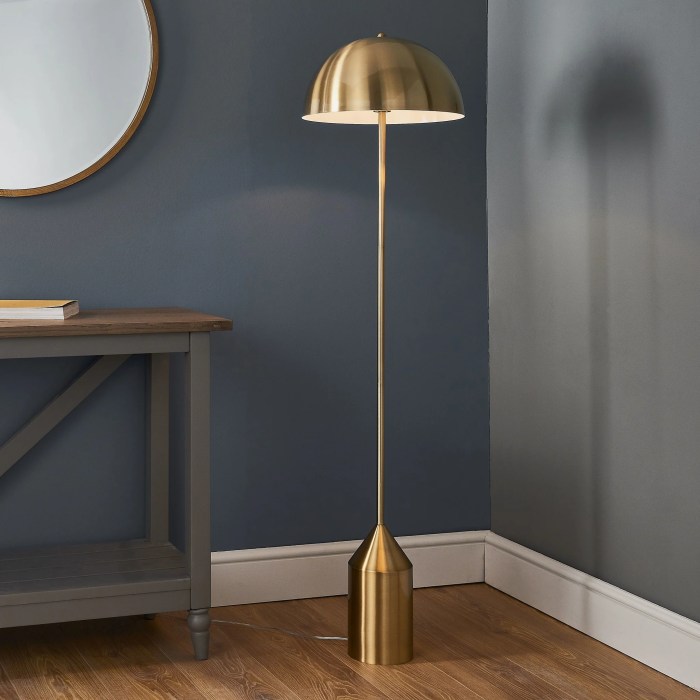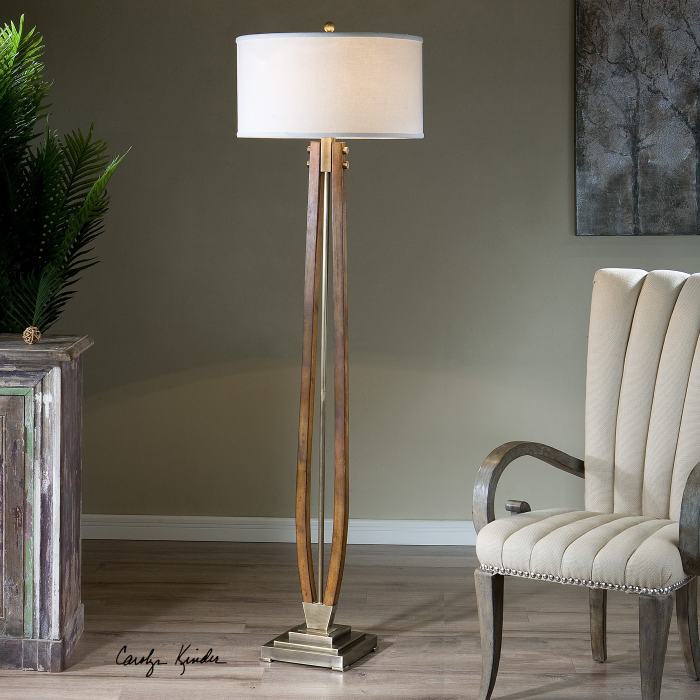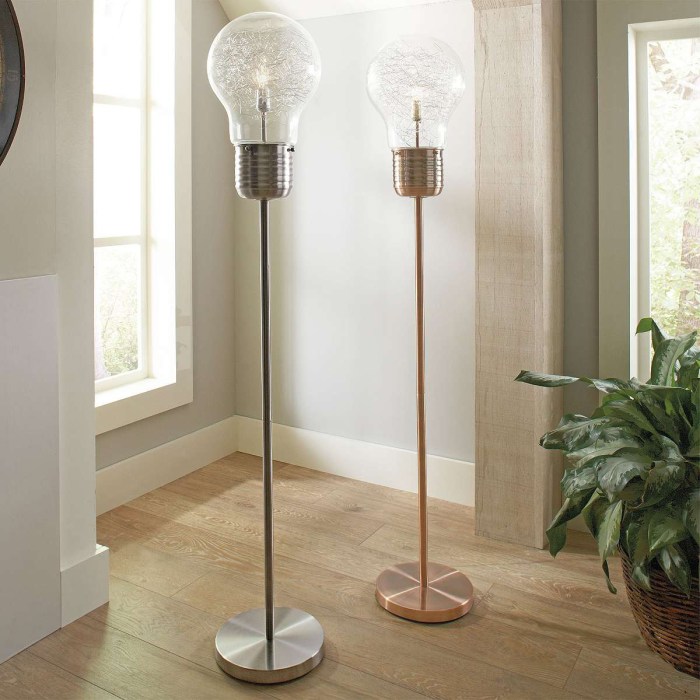Step into the world of floor lamps, where illumination meets artistry. From modern marvels to timeless classics, these versatile lighting fixtures transform your living spaces into oases of ambiance and functionality.
With their ability to cast a warm glow, accentuate architectural features, and create distinct lighting zones, floor lamps are more than just a source of light—they’re interior design powerhouses that elevate the aesthetics and functionality of any room.
Floor Lamp Design and Styles

Floor lamps are versatile lighting fixtures that can complement any room’s décor. They come in a wide range of designs and styles, from modern to traditional, industrial to Scandinavian. The choice of style depends on personal preference and the overall aesthetic of the space.
Modern Floor Lamps
Modern floor lamps are characterized by their clean lines, simple shapes, and use of contemporary materials such as metal, glass, and acrylic. They often feature adjustable heights and heads, making them functional and versatile. Examples include:
- Arc lamps: These have a curved metal arm that supports a shade, creating a dramatic focal point.
- Tripod lamps: These have three slender legs supporting a shade, offering a minimalist and industrial look.
- Floor spotlights: These have adjustable heads that can be directed to illuminate specific areas or objects.
Traditional Floor Lamps
Traditional floor lamps evoke a classic and timeless style. They often feature ornate details, such as carved wood bases, fabric shades, and brass accents. Examples include:
- Torchiere lamps: These have a tall, slender base with a flared shade at the top, providing ambient lighting.
- Tiffany lamps: These are known for their colorful stained glass shades, creating a warm and inviting atmosphere.
- Candelabra lamps: These have multiple arms branching out from a central base, holding candle-shaped bulbs for a dramatic effect.
Industrial Floor Lamps
Industrial floor lamps draw inspiration from factory and warehouse lighting. They typically feature exposed metal frames, pipes, and rivets, giving them a rugged and utilitarian aesthetic. Examples include:
- Anglepoise lamps: These have adjustable arms and shades, allowing for precise task lighting.
- Cage lamps: These have metal cages surrounding the bulbs, providing a vintage and industrial touch.
- Pipe lamps: These are made from metal pipes and fittings, creating a raw and edgy look.
Scandinavian Floor Lamps
Scandinavian floor lamps embody the principles of simplicity, functionality, and natural materials. They often feature clean lines, light wood tones, and organic shapes. Examples include:
- Pendant floor lamps: These have a shade suspended from a ceiling-mounted cord, providing ambient lighting.
- Floor lanterns: These have wooden or metal frames with fabric or paper shades, creating a cozy and inviting atmosphere.
- Minimalist floor lamps: These have a simple, uncluttered design with a focus on functionality.
Materials Used in Floor Lamp Construction
Floor lamps are made from a variety of materials, each with its own unique characteristics:
- Wood: Provides warmth and a natural look, but can be more expensive.
- Metal: Durable and versatile, available in various finishes such as brushed nickel, chrome, and brass.
- Glass: Adds a touch of elegance and can create interesting lighting effects.
- Fabric: Softens the light and provides a cozy ambiance, but can be more delicate.
Functional Features of Floor Lamps

Floor lamps offer a wide range of functional features that enhance their versatility and practicality. These features include different light sources, lighting functions, and adjustable designs.
Light Sources
Floor lamps utilize various types of light sources, each with its own advantages and disadvantages:
- Incandescent:Warm, traditional light; energy-inefficient.
- LED:Energy-efficient, long-lasting; higher initial cost.
- Fluorescent:Energy-efficient, cool light; potential for flickering.
Lighting Functions
Floor lamps serve multiple lighting functions, catering to different needs:
- Ambient Lighting:General illumination for the entire room.
- Task Lighting:Focused light for specific activities, such as reading or working.
- Accent Lighting:Highlights specific objects or areas to create visual interest.
Placement and Use of Floor Lamps

Floor lamps offer versatile lighting solutions, enhancing both functionality and aesthetics. Choosing the right floor lamp and positioning it effectively can elevate the ambiance and functionality of any room.
Choosing the Right Floor Lamp
Consider the room’s size and style when selecting a floor lamp. For smaller spaces, opt for a slim, streamlined design with a compact base. In larger rooms, a taller, more substantial lamp with a wider base will provide ample illumination.
Match the floor lamp’s style to the room’s decor. A traditional lamp with an ornate base complements classic interiors, while a modern lamp with clean lines suits contemporary spaces. Consider the lamp’s shade material as well, with opaque shades blocking light and translucent shades providing a softer glow.
Optimal Placement for Lighting and Aesthetics
Position floor lamps strategically to maximize their lighting capabilities. Place them near seating areas for reading or task lighting. In living rooms, place a floor lamp behind a sofa or armchair to create a cozy reading nook.
Consider the height of the floor lamp. A taller lamp will provide ambient lighting, while a shorter lamp can be used for more focused task lighting. Adjust the lamp’s height and angle to direct light where needed.
Creating Different Lighting Effects and Moods
Floor lamps can create various lighting effects and moods. Use a dimmer switch to adjust the light intensity, creating a warm and inviting ambiance or a brighter setting for reading or working.
Experiment with different shade materials to alter the light’s quality. Opaque shades block light, creating a more focused beam, while translucent shades diffuse light, providing a softer and more ambient glow.
Maintenance and Troubleshooting
Floor lamps require regular cleaning and maintenance to ensure optimal performance and longevity. Proper care involves cleaning the lampshade, base, and electrical components.
Cleaning and Maintenance
Use a soft, dry cloth to wipe down the lampshade and base. For fabric lampshades, use a vacuum cleaner with a soft brush attachment to remove dust. For glass or metal lampshades, use a mild detergent solution and a soft cloth to clean.
Clean the electrical components, such as the socket and cord, with a dry cloth or a slightly damp cloth.
Troubleshooting Common Problems
Common problems that can occur with floor lamps include flickering lights, loose connections, and broken bulbs.
Flickering Lights
Flickering lights can be caused by loose connections, worn-out bulbs, or faulty wiring. Check the connections between the bulb, socket, and cord. If the connections are secure, replace the bulb. If the problem persists, contact an electrician to inspect the wiring.
Floor lamps are a great way to add extra light to a room. They can also be used to create a cozy and inviting atmosphere. If you’re looking for a floor lamp that is both stylish and comfortable, I recommend checking out the koala mattress . The koala mattress is made with high-quality materials and is designed to provide maximum comfort.
It’s also available in a variety of colors and styles, so you’re sure to find one that fits your needs. Whether you’re looking for a floor lamp to brighten up your living room or create a cozy reading nook, the koala mattress is a great option.
Loose Connections
Loose connections can cause the lamp to flicker or not turn on at all. Check the connections between the bulb, socket, and cord. Tighten any loose connections and ensure they are secure.
Broken Bulbs
Broken bulbs should be replaced promptly. Turn off the lamp and allow it to cool before replacing the bulb. Use a new bulb of the same wattage and type as the original bulb.
Replacing Light Bulbs
Regularly replacing light bulbs is crucial for ensuring optimal performance and longevity of the floor lamp. Replace bulbs when they burn out or start to dim. Use bulbs of the same wattage and type as the original bulbs.
Trends and Innovations in Floor Lamps
The world of floor lamps is constantly evolving, with new trends and innovations emerging all the time. These advancements not only enhance the functionality and versatility of floor lamps but also introduce unique and cutting-edge designs to complement modern home decor.
One of the most notable trends is the integration of smart technology into floor lamps. Smart floor lamps can be controlled remotely via smartphone apps or voice assistants, allowing for convenient adjustments to brightness, color temperature, and even scheduling. This level of control elevates floor lamps from mere lighting fixtures to versatile home accessories that enhance comfort and ambiance.
Adjustable Height, Floor lamp
Adjustable height is another innovative feature that has become increasingly popular in floor lamps. This feature enables users to customize the height of the lamp to suit their needs and preferences. Whether you need a tall lamp for reading or a shorter lamp for ambient lighting, adjustable height floor lamps provide the flexibility to create the perfect lighting scenario.
Wireless Charging
With the proliferation of wireless devices, floor lamps with built-in wireless charging capabilities are gaining traction. These lamps not only provide illumination but also offer a convenient way to charge smartphones, tablets, and other compatible devices without the need for additional cables or charging stations.
This feature adds practicality and convenience to modern living spaces.
Unique and Cutting-Edge Designs
Beyond functionality, floor lamp designs are also evolving to embrace unique and cutting-edge aesthetics. From sleek and minimalist designs to sculptural and artistic creations, floor lamps are becoming statement pieces in their own right. Designers are experimenting with new materials, textures, and shapes to create floor lamps that are both functional and visually captivating.
Conclusion
Whether you’re seeking a statement piece for your living room, a cozy companion for your reading nook, or a practical solution for task lighting, floor lamps offer an endless array of possibilities. Embrace their versatility, explore their design styles, and discover how they can illuminate your life in more ways than one.
Questions Often Asked
What are the different types of floor lamps?
Floor lamps come in a wide range of styles, from modern to traditional, industrial to Scandinavian. They can be made from various materials such as wood, metal, glass, and fabric.
What are the different types of light sources used in floor lamps?
Floor lamps use various light sources, including incandescent, LED, and fluorescent. Each type has its advantages and disadvantages in terms of energy efficiency, lifespan, and light quality.
How do I choose the right floor lamp for my space?
Consider the size and style of your room, as well as the desired lighting effect. For ambient lighting, choose a lamp with a wide shade that emits diffused light. For task lighting, opt for a lamp with a focused beam.
How do I maintain my floor lamp?
Regularly clean the lampshade and base with a soft cloth. Check the light bulb regularly and replace it when necessary. Avoid placing the lamp in direct sunlight or near heat sources.